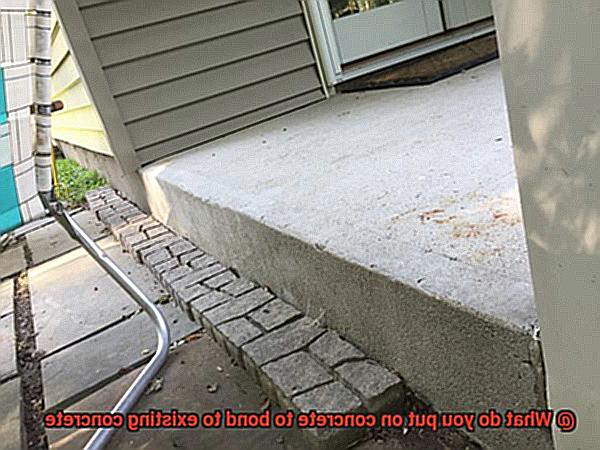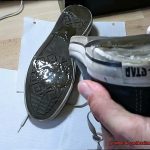Concrete, that sturdy foundation of our built environment, is a marvel of versatility and durability. But when it comes to expanding or repairing existing concrete surfaces, creating a strong bond between the new and old can be quite the challenge. Whether you’re looking to extend your patio, fix a broken sidewalk, or give an old concrete floor a fresh layer, finding the right method is key to ensuring a secure and long-lasting connection.
In this blog post, we’ll dive into various techniques and materials that effectively bond new concrete to existing concrete. From chemical wonders to mechanical marvels, we’ll explore the fundamental principles behind each method, uncover their benefits, and consider important factors for your specific project. So let’s embark on this journey through the world of concrete bonding and discover the techniques that seamlessly unite new and existing concrete surfaces.
What is Bonding Agents?
Contents
- 1 What is Bonding Agents?
- 2 Different Types of Bonding Agents
- 3 Advantages of Epoxy-Based Bonding Agents
- 4 Advantages of Latex-Modified Bonding Agents
- 5 Advantages of Acrylic-Based Bonding Agents
- 6 Benefits of Concrete Overlays or Toppings
- 7 Preparing the Existing Concrete Surface for Application
- 8 Key Considerations for Successful Bonding
- 9 Conclusion
Bonding agents, also referred to as concrete bonding agents or concrete adhesives, are substances used to enhance the bond between new and existing concrete surfaces. They are applied to the existing concrete before pouring or applying new concrete. The primary purpose of bonding agents is to improve the adhesion and cohesion between the old and new concrete, ensuring a strong bond that prevents cracking, delamination, or separation. This is achieved by creating a chemical or mechanical connection between the two surfaces, enhancing the overall integrity and durability of the structure.
Different types of bonding agents exist in the market, including epoxy-based, latex-based, and acrylic-based options. Epoxy-based bonding agents are renowned for their strength and durability. They consist of two components, a resin and a hardener, which are mixed before application. These agents provide excellent adhesion and resistance to chemicals, moisture, and impact, making them ideal for industrial and commercial applications that require high strength.
Latex-based bonding agents are commonly used in residential and light commercial projects. They are easy to apply and offer good adhesion properties. Typically in liquid form, they are mixed with water before application and can be brushed or sprayed onto the existing concrete surface.
Acrylic-based bonding agents provide a balance between strength and flexibility. They offer good adhesion properties and allow for some movement between the old and new concrete surfaces. Available in liquid form, they can be easily applied using a brush or roller.
In addition to improving the bond between existing and new concrete, bonding agents also help reduce shrinkage cracks by providing a continuous layer that enables better stress distribution. They can enhance resistance to freeze-thaw cycles, chemicals, and abrasion.

It is crucial to note that the success of the bond relies not only on the type of bonding agent but also on proper surface preparation. This includes thorough cleaning and roughening of the existing concrete surface to ensure a strong bond. Additionally, following the manufacturer’s instructions for application and curing is essential to achieve desired results.
Different Types of Bonding Agents
Applying a bonding agent and bonding new concrete to existing concrete surfaces:
- Surface Preparation: Before applying a bonding agent, the existing concrete surface should be properly prepared. This may include cleaning the surface to remove any dirt, debris, or loose particles. It is also important to roughen the surface by using mechanical methods such as sandblasting or shot blasting. This helps to create a rough texture that allows the bonding agent to adhere better to the surface.
- Mixing and Applying the Bonding Agent: The bonding agent should be mixed according to the manufacturer’s instructions. This typically involves combining the two components of the adhesive and stirring them together thoroughly. The mixed adhesive can then be applied to the prepared surface using a brush, roller, or sprayer. It is important to apply the bonding agent evenly and ensure that it covers the entire surface area.
- Allowing the Bonding Agent to Cure: After applying the bonding agent, it needs time to cure and develop its adhesive properties. The curing time can vary depending on the type of bonding agent used, as well as environmental conditions such as temperature and humidity. It is important to follow the manufacturer’s instructions regarding curing time and conditions.
- Bonding New Concrete: Once the bonding agent has cured, new concrete can be placed on top of the existing surface. It is important to ensure that the fresh concrete is properly mixed and has the correct consistency for placement. The new concrete should be placed and compacted according to standard construction practices.
- Curing and Finishing: After bonding new concrete to existing concrete, it is important to properly cure and finish the newly placed concrete. This typically involves covering the surface with a curing compound or moist curing methods to prevent moisture loss and promote proper hydration of the cement.
Advantages of Epoxy-Based Bonding Agents
Epoxy-based bonding agents offer a range of advantages that make them a popular choice in the construction industry. These advantages include strong bonding strength, excellent adhesion, versatile application options, moisture and chemical resistance, improved durability, and aesthetic appeal.
Firstly, epoxy-based bonding agents provide exceptional bonding strength. Epoxy is known for its ability to form strong chemical bonds with various surfaces, including concrete. This ensures long-lasting durability and prevents the bond from weakening over time.
Secondly, epoxy-based bonding agents exhibit excellent adhesion properties. They can adhere to both smooth and rough surfaces, making them suitable for bonding to existing concrete. The tight grip provided by epoxy prevents delamination or detachment, ensuring the bond remains intact.
Furthermore, epoxy-based bonding agents offer versatility in terms of application. They can be used for various purposes, such as repairing damaged concrete, overlaying new concrete onto existing surfaces, or enhancing the performance of structural elements. This versatility makes epoxy an ideal choice for both small-scale repairs and large-scale construction projects.
In addition, epoxy-based bonding agents are highly resistant to moisture penetration. Concrete surfaces are often exposed to water or moisture, which can weaken the bond between two concrete layers. However, epoxy resins prevent this issue and ensure that the bond remains strong even in damp environments.
Moreover, epoxy-based bonding agents possess excellent chemical resistance properties. They can resist a wide range of chemicals, including acids, alkalis, solvents, and oils. This protects concrete structures from chemical deterioration and damage.
Additionally, epoxy-based bonding agents significantly enhance the durability of concrete structures. Their high strength and resistance properties make them suitable for high-traffic areas and harsh environmental conditions.
Lastly, epoxy-based bonding agents offer aesthetic appeal. They can be tinted or colored to match existing concrete, providing a seamless and visually appealing finish.
Advantages of Latex-Modified Bonding Agents
Advantages of Latex-Modified Bonding Agents:
- Improved Bond Strength: Latex-modified bonding agents excel at enhancing the bond strength between old and new concrete surfaces. With the inclusion of latex, these agents act as a powerful binder, ensuring a stronger and more durable bond that withstands the test of time.
- Flexibility: In the face of minor movements and expansions in the concrete, latex-modified bonding agents remain steadfast. This flexibility prevents cracks or delamination at the interface between old and new surfaces, guaranteeing a seamless and resilient connection.
- Crack Bridging Ability: Concrete surfaces often fall victim to cracks over time. However, latex-modified bonding agents have a unique ability to span over existing cracks, effectively halting their propagation. By doing so, these agents enhance the durability of the concrete surface and prevent further damage caused by water infiltration or freeze-thaw cycles.
- Compatibility with Various Substrates: Unlike their cement-based counterparts, latex-modified bonding agents are a versatile option compatible with various substrates. Whether it’s concrete, masonry, stone, brick, or even some metals, these agents adapt to different materials with ease, making them an excellent choice for a wide range of construction and repair projects.
- Improved Workability: Thanks to their liquid form, latex-modified bonding agents offer improved workability compared to traditional options. The addition of latex ensures a smoother consistency and better spreadability, making application easier and allowing for proper coverage and adhesion. This advantage proves particularly valuable when working on vertical surfaces or in tight spaces.
- Resistance to Moisture and Chemicals: Latex-modified bonding agents boast enhanced resistance to moisture and chemicals, providing reliable protection for the underlying concrete. By forming a barrier against water penetration and chemical attacks, such as those caused by de-icing salts or acidic substances, these agents ensure the longevity and integrity of the bonded surface.
Advantages of Acrylic-Based Bonding Agents
Acrylic-based bonding agents are a popular choice in construction and concrete repair projects due to their numerous advantages. Let’s explore these benefits in more detail:
- Enhanced Adhesion: Acrylic-based bonding agents excel at improving the adhesion between old and new concrete surfaces. This ensures long-term durability and stability for the structure, preventing potential issues down the line.
- Strong Bonding Properties: These agents boast excellent bonding properties that create a robust and reliable bond between different concrete surfaces. This is crucial in high-stress areas where the bond strength is critical, ensuring the structure remains intact even under heavy loads.
- Waterproof Barrier: Acrylic-based bonding agents provide a formidable waterproof barrier, effectively preventing water penetration and protecting the concrete from moisture-related damage. This is particularly advantageous in areas exposed to harsh weather conditions or frequent water exposure, such as swimming pools or parking lots.
- Compatibility with Various Surfaces: The versatility of acrylic-based bonding agents shines through their compatibility with a wide range of concrete surfaces, including walls, floors, and ceilings. This flexibility makes them suitable for various construction and repair applications, saving time and effort.
- Easy Application: These bonding agents offer hassle-free application, typically coming in liquid form that can be conveniently applied using brushes, rollers, or sprayers. Their relatively fast drying time helps expedite construction or repair projects, reducing downtime.
- Chemical and Salt Resistance: Acrylic-based bonding agents exhibit excellent resistance to chemicals, oils, and salts. This makes them ideal for use in industrial settings or areas prone to chemical spills or exposure, ensuring the integrity of the structure remains unaffected.
- Flexibility: These bonding agents provide some degree of flexibility to accommodate slight movements or expansions in the concrete. This flexibility helps prevent cracking or delamination between the old and new concrete surfaces, maintaining the structural integrity over time.
- Weathering Resistance: Acrylic-based bonding agents have good weathering resistance, ensuring that they maintain their adhesive properties even in harsh climatic conditions. This translates into long-lasting bonds that require minimal maintenance or repairs, saving costs in the long run.
- Cost-Effective: Acrylic-based bonding agents offer a cost-effective solution compared to other alternatives. They provide a reliable and efficient method of enhancing the bond between concrete surfaces without the need for extensive surface preparation or more expensive bonding techniques, making them a budget-friendly choice.
Benefits of Concrete Overlays or Toppings
Concrete overlays or toppings offer a plethora of benefits that make them a go-to choice for anyone looking to improve their existing concrete surfaces. These remarkable solutions not only enhance the appearance of old or worn-out concrete but also provide several other advantages, making them a popular option for homeowners and business owners alike.
One major advantage of concrete overlays is their ability to breathe new life into tired surfaces. With a vast array of colors, patterns, and textures available, overlays allow for customization and can transform any space into a stunning masterpiece. Whether you desire a sleek and modern look or a charming rustic vibe, concrete overlays can bring your vision to life.
Furthermore, overlays possess the magical power to cover up unsightly blemishes, stubborn stains, or pesky cracks that plague the existing concrete. By doing so, they not only enhance the overall aesthetic but also extend the lifespan of the surface by providing an extra layer of protection against further damage.
Cost-effectiveness is another shining star in the constellation of benefits offered by concrete overlays. Unlike the costly and time-consuming process of completely tearing out and replacing old concrete surfaces, overlays require less labor and materials, resulting in substantial cost savings. This makes overlays an affordable option for those seeking to revamp their concrete surfaces without breaking the bank.
Moreover, the application process for concrete overlays is relatively quick and hassle-free. This means minimal downtime and inconvenience for homeowners or business owners who are eager to enjoy their newly improved surface sooner rather than later.
Durability is yet another feather in the cap of concrete overlays. They are designed to withstand heavy foot traffic and various weather conditions, making them suitable for both indoor and outdoor applications. Concrete overlays are resistant to harmful UV rays and aggressive chemicals, ensuring they maintain their impeccable appearance and structural integrity over time.
The customization options available with concrete overlays add an extra dash of excitement to this already exhilarating journey. Features like slip resistance or heat reflectivity can be incorporated to enhance safety and comfort in high-traffic areas such as driveways or pool decks. With concrete overlays, you have the power to create the perfect blend of aesthetics and functionality.
Furthermore, concrete overlays offer environmental benefits by reducing waste. Instead of completely replacing the old concrete surface, overlays eliminate the need for additional materials, minimizing the environmental impact of the project. By choosing concrete overlays, you’re not only elevating your space but also doing your part in preserving Mother Earth.
Preparing the Existing Concrete Surface for Application
Preparing the existing concrete surface for application is a meticulous process that involves several important steps. By following these procedures, you can ensure a strong and long-lasting bond that will result in successful concrete repair or overlay projects.
First and foremost, it is crucial to clean the existing concrete surface thoroughly. Sweep or vacuum away any loose debris, such as dirt, dust, and small stones. This step is essential to remove all surface contaminants and ensure proper adhesion of the bonding material.
Once the surface is clean, it’s time to inspect for cracks and damaged areas. Small cracks can be filled with a concrete patching compound, while larger cracks may require more extensive repairs. It’s important to follow the manufacturer’s instructions when applying these repair materials to ensure a durable and long-lasting bond.
After repairing any cracks, it’s time to roughen the surface. This can be done through techniques such as sandblasting, shot blasting, or grinding. These methods remove the top layer of concrete, exposing a fresh surface with increased roughness. The roughened surface offers more contact points for the bonding material to adhere to, resulting in a stronger bond.
Before applying the new concrete or glue, it is recommended to apply a bonding agent or primer. These products create a chemical bond between the existing and new concrete, enhancing adhesion. Bonding agents penetrate into the pores of the existing concrete, ensuring a strong bond. Follow the manufacturer’s instructions regarding application methods and drying times.
Lastly, ensure that the existing concrete surface is free from moisture before proceeding with the application process. Excess moisture can interfere with adhesion and compromise bond strength. Test for moisture using methods like plastic sheet tests or moisture meters. If excessive moisture is detected, delay the application until the surface is properly dried.
Key Considerations for Successful Bonding
When it comes to bonding concrete to existing concrete, there are several key considerations that must be taken into account to ensure a successful bond. These considerations include the type of adhesive or bonding agent to use, surface preparation, and environmental factors.
Choosing the right adhesive or bonding agent is crucial for ensuring a strong and durable bond between the existing concrete and the new layer. Epoxy resin is known for its exceptional bonding properties and high strength, making it suitable even in challenging conditions such as high moisture levels or extreme temperatures. Polyurethane-based adhesives offer flexibility and resistance to chemicals and abrasion, while cementitious bonding agents are typically used when bonding fresh concrete to existing cured concrete.
Proper surface preparation is vital for achieving a strong bond. Thoroughly cleaning the surface of the existing concrete, repairing any cracks or voids, and roughening the surface through mechanical methods like sandblasting or shot blasting can enhance adhesion.
Environmental conditions also play a significant role in successful bonding. The temperature during bonding should be within the range specified by the adhesive manufacturer to ensure proper curing. High humidity or excessive moisture in the existing concrete can interfere with adhesion, so it is important to ensure that the existing concrete is adequately dried and free from excessive moisture before applying the bonding agent.
Qm4TLiM5go8″ >
Conclusion
In conclusion, there are a variety of options available to bond new concrete to existing concrete, ensuring a robust and enduring connection. Bonding agents, including epoxy-based, latex-based, and acrylic-based adhesives, are commonly utilized to enhance the bond between old and new concrete surfaces.
Epoxy-based bonding agents boast exceptional strength and durability. They exhibit outstanding adhesion and resist chemicals, moisture, and impact, making them perfect for industrial and commercial applications. Latex-based bonding agents are user-friendly and offer excellent adhesion properties. They can be effortlessly brushed or sprayed onto the existing surface. Acrylic-based bonding agents strike a balance between strength and flexibility. They allow for some movement between the old and new surfaces while providing good chemical resistance.
Effective surface preparation is crucial for successful bonding. This entails thoroughly cleaning the existing surface, repairing any cracks or voids, and roughening the surface through techniques such as sandblasting or shot blasting.
Environmental factors like temperature and humidity must also be taken into account during the bonding process. Following manufacturer instructions for application and curing is essential to achieve desired results.
Concrete overlays or toppings present another option for enhancing existing concrete surfaces. These overlays offer customization possibilities in terms of colors, patterns, and textures while effectively concealing blemishes or cracks.






